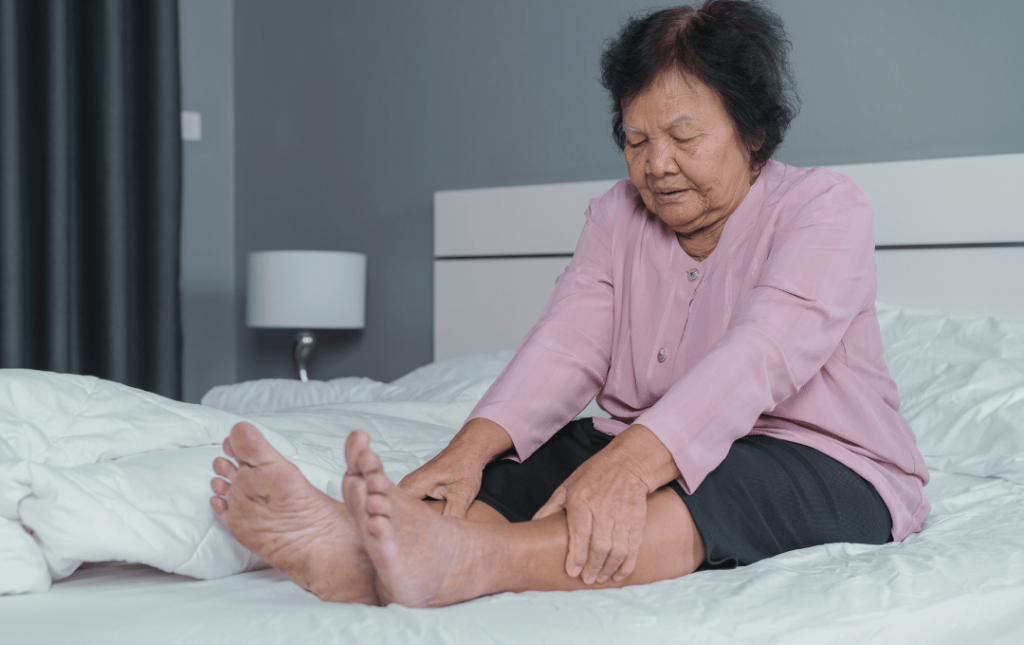Peripheral artery disease (PAD) is a progressive disease that typically impacts the lower legs and feet. This condition is caused by plaque buildup in the arteries, which can restrict blood flow, oxygen, and nutrients to the lower extremities. When blood flow is reduced, it can cause pain and discomfort in the legs.
PAD can impact one or both legs at the same time. However, the severity of the symptoms may vary or progress at different rates in each leg.
Regular vascular screening can help determine if PAD is the cause of your leg pain and prevent these symptoms from worsening. If you exhibit any PAD symptoms in both legs or one, schedule a consultation with a vascular doctor for a thorough evaluation.
Does Peripheral Artery Disease (PAD) Normally Affect Both Legs?
If you believe you have peripheral artery disease (PAD) or you’ve recently been diagnosed, you may be wondering if pain in both legs from the knees down is normal. PAD typically affects both legs at the same time. This is called bilateral peripheral artery disease. This is primarily caused by factors like high blood pressure, diabetes, high cholesterol, and smoking, which accelerate atherosclerosis—plaque buildup on the artery walls—and affect both sides of the body.
However, the severity of the pain may vary from leg to leg, which means one leg may feel weaker than the other at any given time. Some patients may also experience pain in only one leg at first. As the disease progresses, individuals may begin to experience PAD symptoms in both legs. It’s important to note that different lifestyles and underlying health conditions can also cause varying symptoms.
Can You Have PAD in Both Legs Without Knowing?
Yes, you can have PAD in both legs without knowing. Some patients may brush off PAD symptoms as signs of aging, while others may be asymptomatic. Annual vascular screenings ensure the disease is caught early on.
Does Pain in Both Legs Always Mean Peripheral Artery Disease?
No, pain in both legs doesn’t always mean you have PAD. Leg pain can be caused by blood clots, strenuous exercise, or muscle cramps. If you’re experiencing chronic pain in the lower extremities, consult with your vascular doctor for an accurate diagnosis.
PAD Symptoms in Both Legs
Other common PAD symptoms that may occur alongside discomfort and pain in both legs include:
- Weakness and numbness in the legs
- Hair loss and skin discoloration
- Slow-healing ulcers
- Poor circulation
- Tingling in the legs
- Claudication
Blood Clots (like DVT): Usually a One-Leg Problem
Conditions that cause blood clots, like deep vein thrombosis (DVT), typically impact only one leg at a time. Blood clots in both legs at the same time are not common, which is why pain in both legs from the knees down could indicate a different condition, such as PAD. Pain in one leg caused by blood clots is typically sudden, not gradual. You may also notice swelling and redness in the leg.
If you’re experiencing PAD symptoms in both legs or just one, consider scheduling a consultation with a vascular doctor for a full evaluation—especially if you have any of the common PAD risk factors, such as smoking, high cholesterol, high blood pressure, diabetes, obesity, or a family history of vascular disease. Even if your symptoms seem mild or come and go, early detection can help prevent serious complications like ulcers, infections, or even limb loss.
Use our free online assessment to determine if you have common PAD risk factors.
Does Bilateral PAD Mean the Disease Is Worse?
Because PAD generally begins in one leg and slowly progresses to both legs, bilateral PAD is a sign that the disease is worsening. Without treatment, PAD symptoms in both legs can continue to progress into end-stage PAD, potentially leading to more serious complications like heart attack, stroke, and amputation.
Is Treatment Different if Both Legs are Affected by PAD?
Peripheral artery disease treatment can vary depending on the severity of your condition. Bilateral PAD could be a sign of a mild or advanced case. However, symptoms can vary from patient to patient.
At USA Vascular Centers, our experienced vascular doctors provide personalized care based on your unique condition. An accurate diagnosis from one of our specialists will determine how advanced your PAD is and which treatment options are right for you.
If PAD is caught early, several minimally invasive treatments are available at our outpatient centers, including:
- Angioplasty: A small catheter with a balloon is placed at the tip of the affected artery. The balloon inflates and compresses the plaque against the artery walls to help widen the artery. This is typically the first-line treatment for moderate blockages.
- Stent placement: An expandable mesh tube props the affected artery open. Stent placement is typically when there’s a high risk of the artery narrowing again after angioplasty. Carotid stenting and self-expanding stents are also available if an angioplasty is not necessary.
- Atherectomy: A catheter is used to remove plaque from the affected artery that is hard or heavily calcified, which can be difficult to compress with a balloon. A stent can also be placed to avoid future build-ups.
LEARN MORE ABOUT TREATMENT OPTIONS
Find Relief From PAD in Both Legs at USA Vascular Centers
If you’re exhibiting peripheral artery disease symptoms in one or both legs or have been recently diagnosed with PAD, schedule a consultation at USA Vascular Centers. Our vascular specialists will provide an accurate diagnosis and a personalized treatment plan for your condition. Our vascular clinics are fully accredited by the Accreditation Association for Ambulatory Health Care (AAAHC) and have over 45 locations in the United States.
We accept most insurance plans, including Medicare and Medicaid. Schedule your appointment online or by calling us at 888.773.2193.


